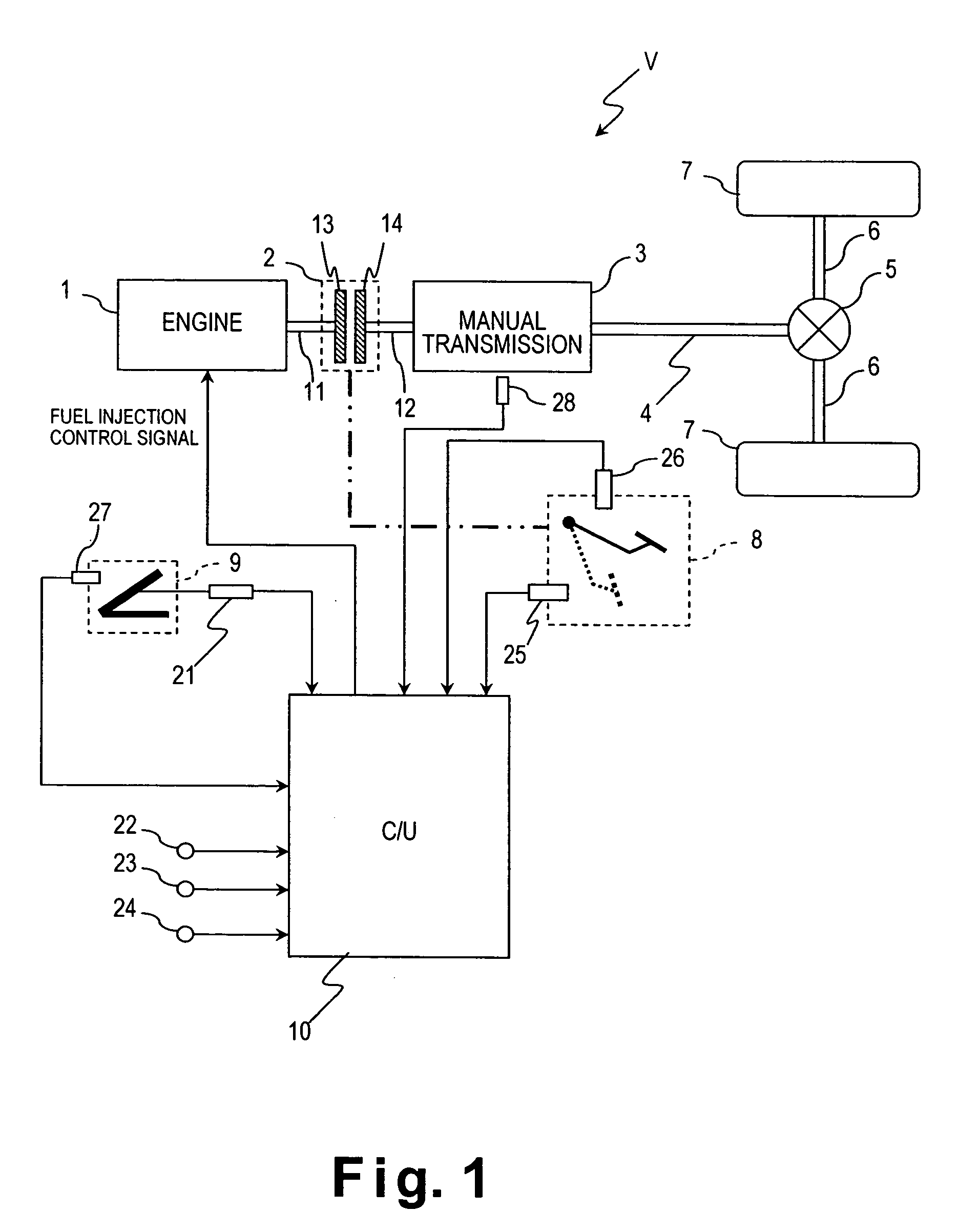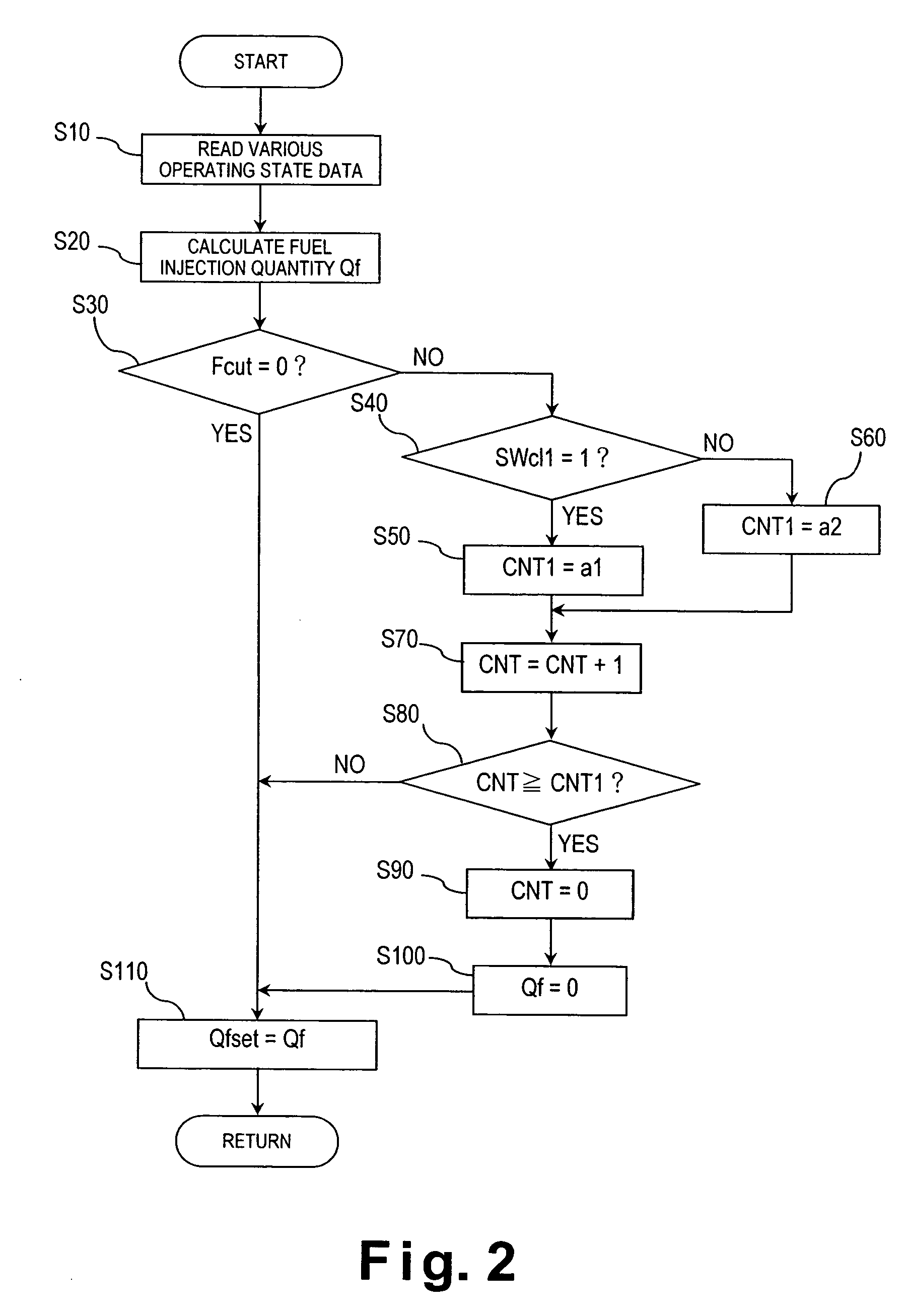Engine fuel supply control device
a control device and fuel supply technology, applied in the direction of electric control, fuel injection control, machines/engines, etc., can solve the problems of above problems that cannot be completely avoided, slow engine speed drop, etc., to improve upshift feel, delay the time of fuel cut-off, the effect of increasing engine output and efficiency
- Summary
- Abstract
- Description
- Claims
- Application Information
AI Technical Summary
Benefits of technology
Problems solved by technology
Method used
Image
Examples
first embodiment
[0044]Referring initially to FIGS. 1-4, a vehicle V is schematically illustrated that is equipped with an engine fuel supply control device in accordance with a first embodiment of the present invention. FIG. 1 illustrates the configuration of the drive system of pertaining to an embodiment of the present invention. This vehicle V has a drive train that includes an engine 1, a clutch 2, a manual transmission 3, a propeller shaft 4, a differential 5 and a pair of wheel drive shafts 6. These components of the drive train are relatively conventional components, and thus, these parts will not be discussed or illustrated in detail herein. The wheel drive shafts 6 are coupled to a pair of drive wheels 7 in a conventional manner to rotate the drive wheels 7. The clutch 2 is engaged or disengaged according to the position of a clutch pedal 8 that is manually depressed by the driver's foot. The rotational speed of the engine 1 is manually controlled by an accelerator pedal 9 that is manually...
second embodiment
[0079]Referring now to FIG. 5, a modified fuel injection quantity calculation routine is illustrated that is executed by the control unit 10 of the vehicle V that is equipped as shown in FIG. 1. In view of the similarity between the first and second embodiments, the parts or steps of the second embodiment that are identical to the parts or steps of the first embodiment will be given the same reference numerals. Moreover, the descriptions of the parts or steps of the second embodiment that are identical to the parts or steps of the first embodiment may be omitted for the sake of brevity. In other words, unless otherwise specified, the processing executed by the control unit 10 in the second embodiment is the same as the first embodiment. Thus, the modified processing will now be discussed.
[0080]FIG. 5 is a flowchart illustrating the fuel injection quantity calculation routine when the supply of fuel is stopped as soon as the clutch 2 is disengaged. This routine is also actuated by tu...
third embodiment
[0085]Referring now to FIGS. 6-8, further modified processing executed by the control unit 10 will be discussed in accordance with a third embodiment of the present invention. This third embodiment is carried out by the control unit 10 of the vehicle V that is equipped as shown in FIG. 1. In view of the similarity between the first and third embodiments, the parts or steps of the third embodiment that are identical to the parts or steps of the first embodiment will be given the same reference numerals. Moreover, the descriptions of the parts or steps of the third embodiment that are identical to the parts or steps of the first embodiment may be omitted for the sake of brevity. In other words, unless otherwise specified, the processing executed by the control unit 10 in the third embodiment is the same as the first embodiment. Thus, the modified processing will now be discussed.
[0086]With the third embodiment of the present invention, the engine control unit 10 controls the fuel bein...
PUM
 Login to View More
Login to View More Abstract
Description
Claims
Application Information
 Login to View More
Login to View More - R&D
- Intellectual Property
- Life Sciences
- Materials
- Tech Scout
- Unparalleled Data Quality
- Higher Quality Content
- 60% Fewer Hallucinations
Browse by: Latest US Patents, China's latest patents, Technical Efficacy Thesaurus, Application Domain, Technology Topic, Popular Technical Reports.
© 2025 PatSnap. All rights reserved.Legal|Privacy policy|Modern Slavery Act Transparency Statement|Sitemap|About US| Contact US: help@patsnap.com



